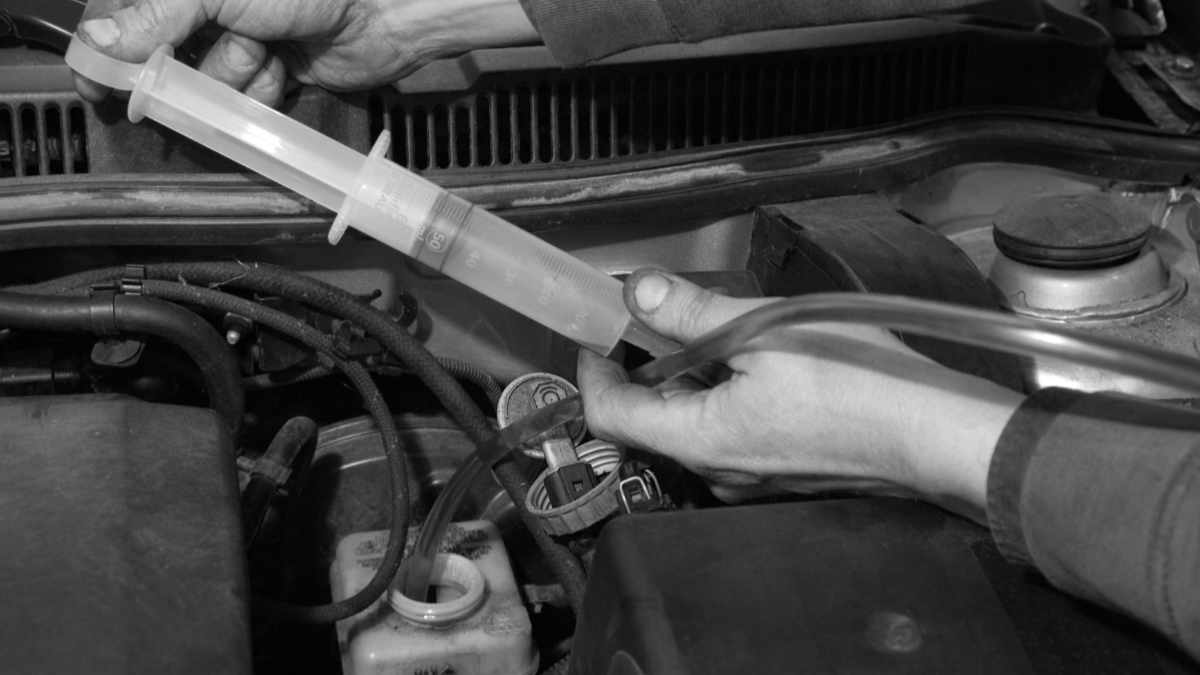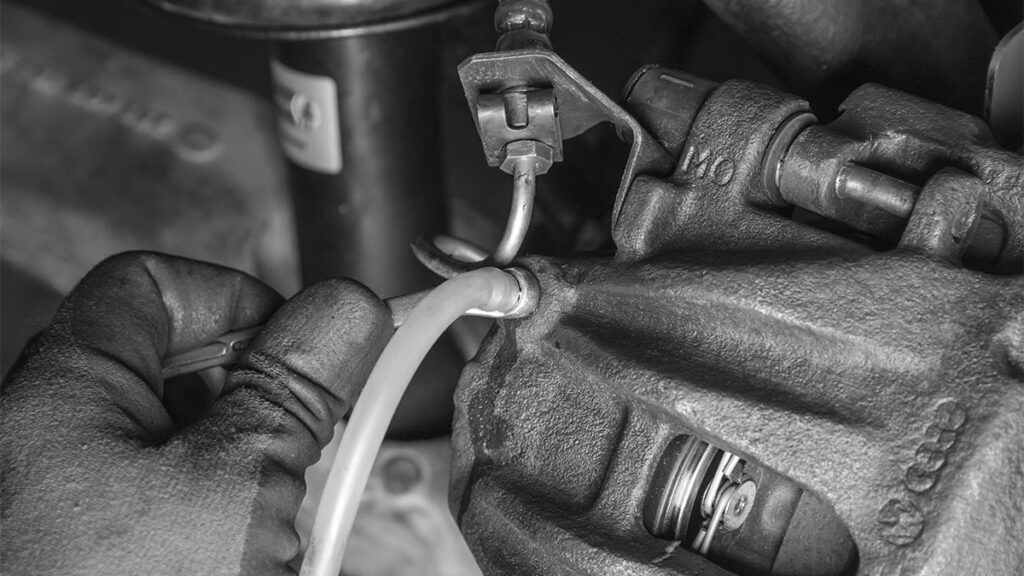Venting principle
We already covered this in the overview article: The easiest way to expel air from the brake system is to pump brake fluid through the whole system. It doesn’t matter whether you simply “bleed” the system or flush it to change the brake fluid – the only tools required are an empty reservoir and a hose. The glycol mixture is then simply moved with the brake master cylinder; it presses fresh brake fluid into the system sip by sip.
Check vent valves
Before starting the actual work, however, it can’t hurt to take a look at the four bleeder valves on the four brake calipers or wheel brake cylinders – after all, this is exactly where the old brake fluid should leave the system. Such a bleeder valve is actually a clever invention and basically consists of a hollow drilled screw with a conical sealing surface at the base. This sealing surface turns the screw into a valve: If the screw is loosened by even half a turn, the brake fluid can flow through the gap at the base into the hollow interior of the screw and then through the attached hose into the collection container. Tadaaaa!
However, this ingenious invention in itself becomes a nail in the coffin of the brake calliper if it is not moved for years or decades. During this time, the part, which is already weak due to the bore, bogs down and, to the amazement of the observer, tears off flush as soon as you turn it. Hurrah!
Before the bleeding procedure, we therefore recommend a brief attempt to unscrew the small amphibians: If this doesn’t work without a lot of fuss, you MUST loosen or replace the bleeder valves first . Incidentally, as a secret weapon against seizing, we recommend using a layer of Teflon tape around the valves .

Auxiliary tool
To bleed the air using pedal power, you need a hose and a container of some kind. In a pinch, this container is actually a mustard jar from my mother’s kitchen cupboard. Unfortunately, these things are too small, quite fragile, have no lid and no hook to hang them on.
So if you frequently tinker with brakes, at some point you will automatically end up with brake bleeding containers: these things easily swallow a liter of old brake oil, are leak-proof, can be dropped safely and also have a proper silicone hose on them. What’s more, they can be attached to the underbody with a hook if the car is raised on a lift.
The silicone hose feature is not entirely unimportant: transparent hoses made of PE become brittle, cloudy or cracked over time. A nice detail of the not-so-expensive patent container is the fact that the loose end of the hose can be elegantly attached to the free end of the hook.

Main actor master brake cylinder
Apart from ultra-modern brake-by-wire systems, the brake master cylinder has hardly changed in recent decades: It converts the linear movement of the brake pedal into hydraulic pressure. To do this, two pistons move in its housing, which do two things at the same time as soon as the driver presses the brake pedal: on the one hand, they close the equalizing and overrun bore and, on the other, they press brake fluid into the connected brake lines to the wheel brake cylinders or the ABS block. This closing of the equalizing or overrunning bore (towards the equalizing reservoir) is important – after all, the entire pressure should go into the brake system.
Conversely, all brake cylinders and the expansion tank are connected to each other when the driver does NOT press the pedal. And for this reason, the entire expansion tank runs empty if any brake line is removed and not closed.
Master cylinder seals
Master brake cylinders are sealed on the outside and inside with seals. Depending on the design of the cylinder, the inner seals separate the two pressure chambers of the brake circuits from each other, for example, and ensure that no brake fluid flows back into the expansion tank.
It is only logical that o-rings and shaft seals (on the piston) that move back and forth work their way onto their sealing surfaces over the course of years and decades. Formerly slightly rough surfaces in the cylinder then become as smooth as glass and a small burr can build up at the end of the actuation path.
The horror vision of all those who advise against pump bleeding is therefore quite understandable: Burr is run over during pumping, seal is broken, master cylinder is then leaking internally. What is possible in theory also happens in practice. However, it is extremely rare and is mainly found in systems that have been tormented by a lack of maintenance (water in the brake system) anyway. Here, traces of corrosion can be found in the form of small pittings in the brake master cylinder. Such a cylinder actually leaks internally and is then ready to be thrown away.
However, a well-maintained brake master cylinder can cope with pump bleeding, even if it has been around for many years. If you are not sure what the thing is still good for, simply carry out a pressure test.
Fresh liquid
Is it necessary to mention that the brake fluid must be fresh? In this case, fresh means “from a sealed original container”. This is because brake oil as a glycol mixture is about as hygroscopic as the Pope is Catholic. If you leave the stuff open, it will absorb one or two percent water by weight within a few hours. This, in turn, lowers the boiling point and ensures that at some point – poof! – you step into the void on the descent with a glowing brake disk and hot caliper.
Used brake fluid then looks cloudy and dark, fresh mixture is clear, light yellow and reminds you of, well, we know. As the stuff ages both in the cylinders and in the expansion tank, it must also be removed from this tank. The easiest way to do this is with a proper syringe from the pharmacy – attach a hose instead of a cannula and suck it out. The dirt trap sieve in the expansion tank can be safely pulled out of its seat with needle-nose pliers to slurp out the last sip from the bottom of the tank. Then put it back in again.
Once the used brake fluid has been removed, fill the reservoir with fresh and suitable brake fluid – up to the stand-up collar. After all, the next step is to pump half of it back through the system.

You don’t want to be out and about in the Alps with the fluid on the right.



The second woman
Only very, very few vehicles are so small that the span of both arms is sufficient to operate the brake pedal and turn the bleeder valves at the same time. For this reason, a second man is needed to bleed the pump. Or even the woman of the house, because all the men have strangely spread themselves thin under the pretext of urgent matters that cannot be postponed.
Once you have checked all the bleeder valves, emptied and refilled the expansion tank and, most importantly, prepared the patent catchment miracle bottle, you are ready to go:
While the lady of the house lolls around in the driver’s seat, the master of the workshop crawls under the car, puts the hose on the first bleeder valve and opens it with perhaps half a turn. Then the battle cry to the gentleman: “Pump it!” – whereupon the lady slowly pushes the pedal down to the floor panel and holds it there.
In the meantime, the old brake fluid and air bubbles run through the transparent hose and slowly drip into the collection container. If flow stops, the pedal is on the floor plate. Then close the valve again, command “foot back” and the same game starts all over again.

Letzte Aktualisierung am 2024-04-05 / Affiliate Links / Bilder von der Amazon Product Advertising API
Freshly filled and vented
The brake line and the relevant cylinder are bled and filled with fresh mixture as soon as the brake fluid comes out clear, clean and without air bubbles. The lady of the house now has a break – the gentleman presses the rubber plug onto the open end of the bleeder valve, refills the expansion tank and crawls to the next brake calliper.
Incidentally, the sequence of this crawl space under the vehicle is almost always the same. Brake lines typically branch off from the ABS block or run directly from the master brake cylinder to the wheel brake cylinders. If the manufacturer specifies a strict sequence in its service literature, you are of course welcome to follow it.
Once all four wheels have been treated, it’s time for the cross-check to see if there is still air in the system: start the engine so that the brake booster is running and slam on the brakes. Release the pedal and slam it in again. And again.
Is the pressure point always the same? The pedal is always in the same place “dry” and does not give way? Well done!





